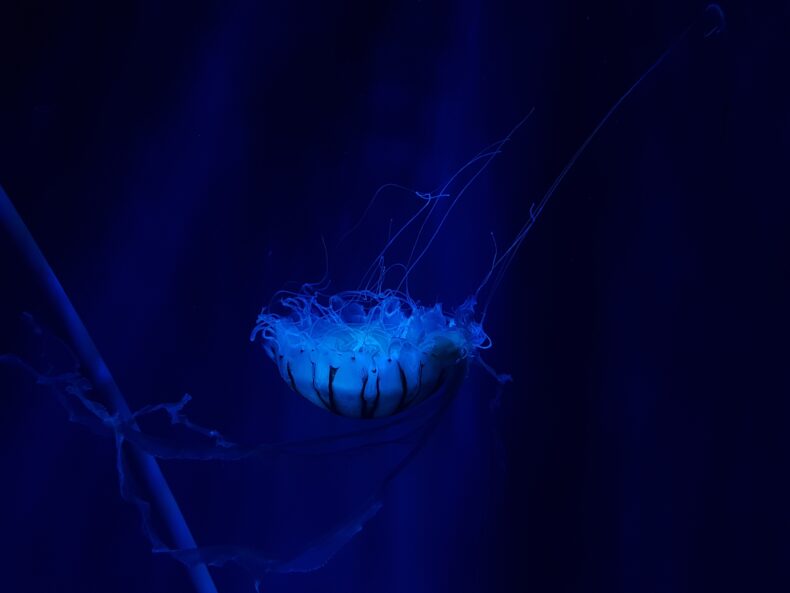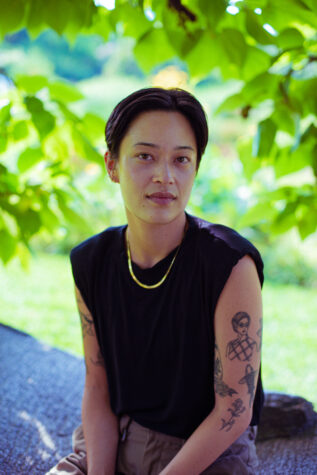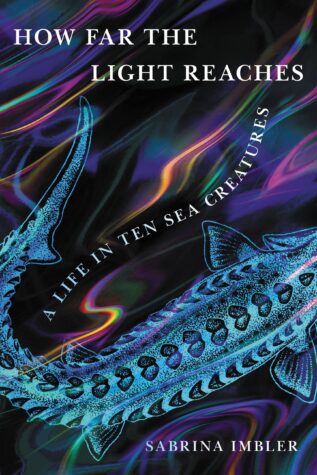
After a long, miserable summer of illness, I’m back, and I’ve got something extra-marvelous to share: an interview with Sabrina Imbler (they/them), a fellow poet/essayist/science writer and the author of the forthcoming collection HOW FAR THE LIGHT REACHES: A Life in Ten Sea Creatures. Our conversation about writing, publishing, and (what else?) marine invertebrates was so rich that it can’t be contained in a single post, so stay tuned for an absolute banger of a Part II next month. NOTE: This interview has been edited for clarity and length.
Kate: What first sparked this project? Was there a single moment when you thought, “Oh, this is gonna have to be a book?”
Sabrina: I guess the origin would have to be the octopus essay. I’d learned about one individual of the deep-sea species Graneledone boreopacifica when I was doing this part-time job writing clickbait about the ocean. I was writing these horrible aggregated posts, like, “You’ll Never Guess Where They Found This Seal!” I was just searching “sea animal” in Google News to find things to blog about, and that’s how I learned about this individual octopus who brooded her eggs for four and a half years without eating. I was so stunned by this particular mode of living. At the time, I wasn’t in a position to write about it. I blogged about it, but that was just summarizing real reporting, and this felt like a very emotional story.
A year later, I was still thinking about this octopus. That’s when I came to the understanding that I found the story particularly moving because of my own relationship with disordered eating and my mother’s relationship with disordered eating. And I wondered what it might look like to tell those stories together.
I pitched the column to a website called Catapult as a series of essays that paired a creature with my own experience. The octopus was the first entry.
That column was the place where I began to experiment with the form and see what worked and what did not work. Then someone on Twitter—Melissa Hung, a writer—tweeted, like, “What are you gonna do with this column? You should make it a book.” I’d never thought of that before. I think I just imagined writing these essays for like $200 on the internet forever.

Kate: What was the process of finding a publisher like?
Sabrina: Publishing is very confusing. When I decided I wanted to turn the essays into a book, I applied to two writing retreats and conferences. One was the Tin House workshop, and the other was called Jack Jones Literary Arts. The Tin House workshop was really helpful because there were all of these craft talks, and agents would speak about their own experience and what they look for in clients. It was helpful to get an overview of how the industry works.
The Jack Jones Literary Arts retreat, which happened later that year, was such a gift. I was able to go on a scholarship that was funded by Alexander Chee in the memory of his late grandmother Yi Dae Up. It was so helpful. It felt like a crash course in publishing. It was led by Kima Jones, who is a wonderful and very generous writer, who decided to make a retreat for writers of color. At the time, it was only open to women, to teach what it’s like to be a writer of color in this industry that will try to capitalize on your identity and your trauma. It felt like a really safe and nourishing space.
That’s also where I met my agent, Ayesha Pande of Ayesha Pande Literary. I’m so grateful to have met her. She’s been a really tireless advocate and supporter throughout this process. She sold my book to Jean Garnett at Little, Brown. I think we’d had four or five offers.
Kate: Wow.
Sabrina: It was very surreal. But the advances were quite small, compared to fiction, so it really came down to going with the editor I trusted, who I really think believes in this project but also has criticisms of it and wants it to be the best it can be. I think that Jean is the smartest person I’ve ever met.

Kate: Was there any creature or personal experience you wanted to write about but didn’t, or anything you had to cut?
Sabrina: Definitely. I think I pitched the proposal when I was like 25 or 26 or something. I was so young and I had a very different idea of the book than what it turned out to be. One of the things I pitched was about a sea slug that looks like Guy Fieri. It has frosted tips and steals venom to wield against its enemies. The frosted tips was really the main metaphor. I thought it would be funny. But every time I tried to write that essay, my heart just wasn’t in it. I didn’t have much more to say.
There was another essay that was originally in the Catapult column that I wanted to expand for the book, but I had a lot of trouble doing it. It was about Ernst Haeckel, the scientific illustrator. I have several tattoos of nudibranchs that he illustrated. But I got them before I learned he was a eugenicist. I learned about this in the first era of internet cancellation and was like, “I should have all of my tattoos covered up.” Thank god I didn’t do that. It’s complicated, but that’s not necessarily the right response. So I tried to expand that into an essay of my own personal experiences being a person of color in science journalism, and how I often felt very alienated. I experienced my quota of microaggressions. But as I was writing it, I realized, There is no way I can write this without it feeling so petty, and having all of these experiences being traceable to certain people, and I don’t want to get sued. And we’re all learning. I dumped that essay, because I was like, “Maybe this isn’t something to write about. Maybe it’s something I can think about.” Which is another big lesson.
Kate: Of the pieces that did make it into the book, which one is your favorite?
Sabrina: Oh, wow. I think I have a tie. I think my favorite essay is the immortal jellyfish essay, because it’s so different. The pieces I wrote last also happened to be the last pieces in the book, and I was finding my own limits about how much I could write about myself and still feel interested. The immortal jellyfish essay was one that was originally in the Catapult column. The idea was, here’s the jellyfish and here’s my own re-imagining of the past, swapping back and forth. But by the time in the book process that I had to expand it, I was like, “This is so boring. I have nothing left to say about myself.”
I was reading a popular science book about seagulls in which the author has the voices of other people interrupt the text for long blocks. I loved the idea that no single one of us is the expert of a situation. How can we include more perspectives in the story? Especially for an essay about reimagining, it feels so limiting to just go deep into my own imagination. I liked the idea of exploding the narrative beyond myself at the end of the text. It was very tricky to get together, because I had never worked on an essay with multiple contributors, and I learned a lot about how to do that in a way that respects everyone’s time. But it’s the essay I love to read because I feel so inspired by what everyone else wrote, and so touched they would share their words for this project. I really love it.
The other one I love is the salp essay, because I think it’s my best writing in the whole book.
*
That’s it for Part I. Come back in December to read about Sabrina’s love for their fact-checker; making peace with the reality of publishing a past self; and the squirmy, wormy appetite of their ideal blurb-writer.
Image credits: Unsplash (jelly); Marion Aguas (author photo); Little, Brown and Company (book cover)
“Maybe this isn’t something to write about. Maybe it’s something I can think about.”
whew gonna be thinking about that for awhile!!! can’t wait for part 2 (and sabrina’s book)
jane: agreed! i think this might be one of those things that i have to just keep learning over and over and over.